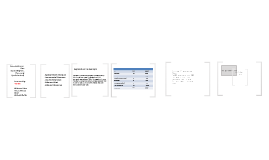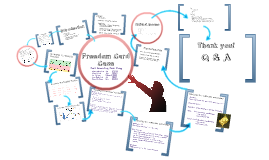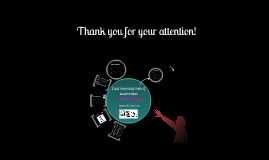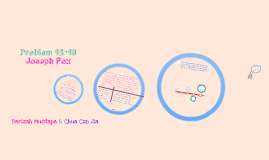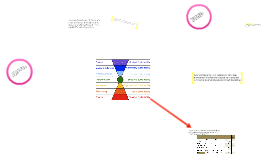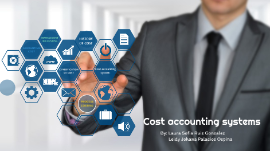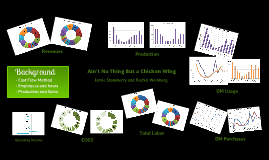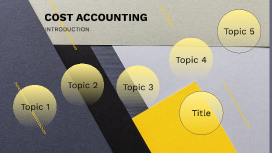COST ACCOUNTING
Transcript: By: Laura Sofia Ruiz Gonzalez Leidy Johana Palacios Ospina Cost accounting systems ACCOUNTING COST ACCOUNTING COSTS BRANCH OF MANAGEMENT ACCOUNTING WHICH IS RELATED TO THE ACCUMULATION AND THE ANALYSIS OF COST INFORMATION FOR INTERNAL USE IN THE VALUATION OF INVENTORIES. PLANNING, CONTROL AND DECISION MAKING SYNTHESIZES AND REGISTER THE COSTS OF A COMPANY SO THAT THEY CAN BE ME ASURED AND CONTROL. THE RESULTS OF EACH ONE OF THEM THROUGH THE OBTAINING OF TOTAL AND UNIT COSTS. MANAGEMENT ACCOUNTING MANAGEMENT ACCOUNTING Is the information system designed to meet the internal needs of the company. Facilitates decision making and measurement of actions of the elements of the organization in relation to the plans and budgets established by it. HISTORY OF COST The emergence of cost accounting can be found before the Industrial Revolution. This cost system was used by some European industries between the years 1485 and 1509. In 1778, auxiliary books began to be used in all the items related to the cost of the products, such as wages, work materials and delivery dates. HISTORY OF COST DEVELOPMENT Approximately between the years 1890 and 1915, cost accounting managed to consolidate an important development, since it designed its basic structure, integrated the cost records into the accounts in countries such as England and the United States, and opted concepts such as: establishments of procedures for the distribution of indirect manufacturing costs, adaptation of reports and records for internal and external users, valuation of inventories, and estimation of costs of materials and labor. ACCOUNTING AS A TOOL The accounting began to be understood as a planning and control tool, which demanded the need to create new ways to anticipate the simple historical economic facts. Some reasons that show it are: The development of the railways. The value of the fixed assets used by the companies that made appear the need to control the indirect costs. The size and complexity of companies in addition to the difficulties administrative problems they faced. The need to have a reliable tool that allowed them to set sale prices. CLASSIFICATION OF COST CLASSIFICATION OF COST ACCORDING TO THE AREA WHERE THEY ARE CONSUMEN PRODUCTION COSTS DISTRIBUTION COSTS ADMINISTRATION COSTS FINANCING COSTS ACCORDING TO YOUR IDENTIFICATION DIRECT INDIRECT ACCORDING TO THE MOMENT IN WHICH IT IS CALCULATED HISTORICAL PREDETERMINED ACCORDING TO THE MOMENT IN WHICH THE RESULTS ARE REFLECTED PERIOD COSTS PRODUCT COSTS ACCORDING TO THE CONTROL YOU HAVE OVER YOUR CONSUMED CONTROLLABLE COSTS UNCONTROLLABLE COSTS ACCORDING TO THE TYPE OF PAYMENT IN WHICH IT INCURS DISBURSABLE COSTS OPORTUNITY COSTS ACCORDING TO YOUR BEHAVIOR FIXED COSTS VARIABLE COSTS SEMI-VARIABLE COSTS MIXED COSTS STAGGERED Cost accounting system: JOB ORDER COSTING IS A COST ACCOUNTING SYSTEM THAT ACCUMULATES MANUFACTURING COSTS SEPARATELY FOR EACH JOB. IT IS APPROPRIATE FOR FIRMS THAT ARE ENGAGED IN PRODUCTION OF UNIQUE PRODUCTS AND SPECIAL ORDERS. FOR EXAMPLE, IT IS THE COSTING ACCOUNTING SYSTEM MOST APPROPRIATE FOR AN EVENT MANAGEMENT COMPANY, A FURNITURE PRODUCER, A PRODUCER OF VERY HIGH COST AIR SURVEILLANCE SYSTEM, ETC. FEATURES OF JOB COSTING A) IT IS A SPECIFIC ORDER COSTING. B) THE JOB IS CARRIED OUT OR A PRODUCT IS PRODUCED TO MEET THE SPECIFIC REQUIREMENTS OF THE ORDER. IT MAY BE RELATED TO SINGLE UNIT OR A BATCH OF SIMILAR UNITS. C) IT IS CONCERNED WITH THE COST OF AN INDIVIDUAL JOB OR BATCH REGARDLESS OF THE TIME TAKEN TO PRODUCE IT, BUT NORMALLY SHORT DURATION JOBS. D) COSTS ARE COLLECTED TO EACH JOB AT THE END OF ITS COMPLETION. THE END OF THE ACCOUNTING PERIOD. E) THE COSTS OF EACH JOB ARE ASCERTAINED BY ADDING MATERIALS, LABOR AND OVERHEADS. F) ONLY PRIME COST ELEMENTS ARE TRACEABLE, AND THE OVERHEADS ARE APPORTIONED TO EACH JOB ON SOME APPROPRIATE BASIS AND SOMETIMES IT IS DIFFICULT TO SELECT A SUITABLE METHOD OF ABSORPTION OF OVERHEADS TO INDIVIDUAL JOBS. G) STANDARDIZATION OF CONTROLS IS COMPARATIVELY DIFFICULT AS EACH JOB DIFFERS, AND MORE DETAILED SUPERVISION AND CONTROL IS NECESSARY. H) WORK-IN-PROGRESS MAY OR MAY NOT EXIST AT THE END OF THE ACCOUNTING PERIOD. * JOB ORDER COSTING OFFERS A DETAILED ANALYSIS OF THE COSTS OF MATERIALS, LABOR COST AND OVERHEADS BY FUNCTIONS AND NATURE. * JOB ORDER COSTING MAKES IT POSSIBLE TO APPRAISE THE PROFITABILITY OF A JOB. * JOB ORDER COSTING FACILITATES THE ESTIMATION OF THE COST OF A SIMILAR JOB. * JOB ORDER COSTING ALLOCATES OVERHEADS ON THE BASIS OF A PREDETERMINED RATE. * JOB ORDER COSTING MAKES EASY TO IDENTIFY SPOILAGE AND DEFECTS TO TAKE CORRECTIVE ACTIONS. * JOB ORDER COSTING EVALUATES EFFICIENCY OF DIFFERENT TYPES OF JOBS WITH COST RECORDS BY USING STATISTICAL TECHNIQUES. ADVANTAGES OF JOB ORDER COSTING * JOB ORDER COSTING NEEDS A GREAT DEAL OF CLERICAL WORK IN RECORDING MATERIAL ISSUE, WAGE COMPUTATION AND PAYMENT AND OVERHEAD CHARGES. * ASCERTAINMENT OF OVERHEAD RATE NEEDS ALLOCATION AND APPORTIONMENT OF THE OVERHEADS






